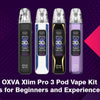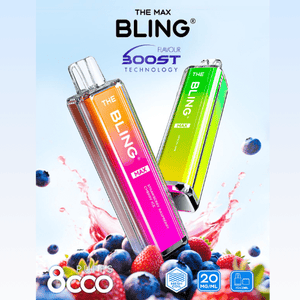Disposable vapes: Everything you need to know

Disposable vapes: Everything you need to know
Has the uncompromising pursuit of convenience led to a surge in single-use items with questionable sustainability?
Understanding Disposable Vapes
Components and Operation
Disposable vapes epitomise simplicity—housing a battery, vaporisation chamber, and a pre-filled e-liquid reservoir within their compact framework.
Despite their transitory nature, disposable vapes encompass a sophisticated harmony of components designed for optimal vapour delivery.
A fully integrated heating element, or coil, is activated upon inhalation, thereby vaporising the e-liquid and producing the aerosol, often referred to as vapour, which delivers the desired nicotine and flavourings.
The operation is an exemplar of streamlined vaping—no buttons to press, no settings to adjust, just immediate satisfaction guaranteed from the first puff, enabling vapers to enjoy a hassle-free experience.
Varieties and Flavours
Disposable vapes offer a spectrum of flavours, catering to a range of palates and preferences.
Since their inception, manufacturers have relentlessly expanded flavour profiles, offering everything from classic tobacco to exotic fruits and desserts.
Today, the market's assortment of disposable vapes includes options such as menthol, confectionery, beverages, and complex blends boasting layers of nuanced tastes.
Advancements in flavour formulation have led to creations that mimic real-world foods and drinks with remarkable fidelity, delivering multisensory experiences to users.
For individuals seeking a specific flavour experience, the disposable vape's range provides a convenient and accessible solution.
Cost Implications
Initial costs of disposables are deceptively modest, given their ready-to-use nature.
Consumers must weigh the longevity of disposables against their repeated costs, as the price accumulates with consistent use over time.
In the context of habitual vaping, disposables may not be the most economical choice, especially when paralleled with rechargeable devices that offer refillable options.
Considering the cumulative expense, vapers who favor disposables must account for the necessity of multiple purchases as each unit reaches its lifespan's end—often after approximately 500 puffs.
Awareness of the ongoing financial commitment is paramount for those considering disposables as a primary vaping method.
Health and Safety Considerations
In the realm of disposable vaping devices, the onus of health and safety lies predominantly with the user. Comprehending the mechanisms of these devices, including their built-in batteries and pre-filled e-liquid reservoirs, is essential. Overheating or improper disposal can have detrimental effects, hence adherence to manufacturer guidelines is paramount to mitigate risks.
Reiterating the importance of conscientious use cannot be overstated—particularly in the context of a product designed for single-use. Potential risks include 'dry hits', a result of depleting e-liquid before the end of the battery's life, leading to unpleasant taste and possible inhalation of harmful compounds. Furthermore, the environmental implications of discarding electronic waste necessitate stringent disposal practices as per local regulations, to ensure these devices do not contribute to hazardous waste issues.
Potential Health Risks
The implications of using disposable vapes extend beyond mere convenience, encompassing various potential health concerns that users must be acutely aware of. Chief among these is the inhalation of chemicals released during the vaporisation process, which may include harmful substances like propylene glycol and vegetable glycerine when heated to high temperatures.
Nicotine addiction remains a paramount concern with disposable vapes. While offering a smoke-free alternative, the nicotine content can perpetuate dependence, thereby negating the ostensible benefits of switching from traditional tobacco products.
Several studies have suggested a correlation between e-cigarette use and respiratory issues, which could manifest due to the inhalation of ultrafine particles and potential contaminants that might be present in the e-liquid. These can range in severity from minor throat irritation to more significant lung damage, warranting a cautious approach to disposable vape usage.
Moreover, the consequences of consuming counterfeited or substandard products pose an increased health risk, as the provenance and quality of the e-liquid cannot be assured. Given the absence of comprehensive regulation specific to disposable vapes within certain jurisdictions, end users could inadvertently be exposed to deleterious substances. It is, therefore, crucial to purchase such devices from reputable sources, and users should be attuned to alerts or recalls issued by health authorities concerning compromised products.
Safe Usage Tips
Ensure battery safety to prevent hazardous malfunctions.
Disposable vapes, much like any electronic device, rely on lithium-ion batteries which are susceptible to potential malfunctions if misused. It is imperative to store and handle these units with care, avoiding extremes of temperature and physical damage, as these factors can perturb the integrity of the battery. Moreover, one should be vigilant for signs of battery fatigue such as overheating or unusual sounds, as these can precede malfunction.
Never tamper with the internal components.
The urge to modify a disposable device can be strong – be it to try to refill the liquid or adjust the battery – but this undermines the inherent safety features. Adhering to manufacturer guidelines ensures the device functions as intended.
Only purchase from authorised dealers with product guarantees.
In the realm of disposable vapes, the importance of procuring devices from accredited merchants cannot be overstated. These establishments are more likely, in compliance with the Tobacco Products Directive 2021, to carry products that have undergone rigorous inspections. These protocols ensure adherence to safety standards, offering vapers peace of mind through quality assurance.
Monitor and adhere to expiration dates for e-liquids.
Expiry dates on e-liquids are not merely a suggestion; they reflect the shelf life after which consumption could pose a potential health jeopardy. Ingredients within e-liquids can degrade over time, potentially leading to inhalation of by-products that have adverse health implications. Observing these dates is fundamental in the pursuit of safe vaping practices.
Environmental Impact
Disposable vapes, although convenient for end-users, present significant environmental concerns primarily due to their single-use nature. The burgeoning market has seen an influx of these devices, which are typically non-rechargeable and non-refillable, leading to increased waste. Compounding the issue is the fact that they contain lithium batteries and plastics, which are not biodegradable and challenging to recycle effectively. Consequently, the rise in popularity of disposable vapes could lead to an exacerbation of the plastic waste crisis and an elevation in hazardous materials dispersion.
Moreover, legislative measures specifically targeting the environmental impact of disposable vapes are yet to be fully realized. The current frameworks for waste management do not adequately address the disposal and recycling of vaping products, leading to a gap in regulatory oversight. This poses the risk of improper disposal, with the consequent leaching of toxic components into the environment, underscoring the need for robust environmental policies tailored to the idiosyncrasies of vape waste.
Waste and Recycling Challenges
The environmental repercussions of disposable vapes are increasingly salient amidst the broader context of global waste management failures. Their single-use design conflicts directly with sustainable waste hierarchies that prioritize reduction, reuse, and recycling.
Therein lies a paradox; disposable vapes offer a less harmful alternative to traditional smoking for users but create environmental burdens that despoiled locales cannot manage. Despite the recognition of this dichotomy, the pursuit of practical recycling avenues for vape products remains nascent and fragmented, invoking the need for systemic solutions.
Furthermore, the lithium-ion batteries embedded within disposable vapes present a distinct hazard when not disposed of properly. If ruptured or compromised, these batteries pose a risk of fire and chemical leakage, challenging waste management entities and necessitating stringent safety protocols.
The onus is now on both manufacturers and policymakers to innovate and implement responsible disposal mechanisms for this burgeoning waste category. Until then, the influx of disposable vapes dovetails with an overarching waste management quandary, one with palpable environmental stakes.
Sustainable Alternatives
Innovative paths must be pursued vigorously.
Developing alternative strategies to the current single-use model is paramount. Refillable vape devicesor pods when necessary. This approach not only curtails waste but also allows for greater customisation and potentially higher quality vaping experiences.
The market burgeons with eco-friendlier choices.
The solution lies not merely in product redesign, but also in consumer shifts towards these sustainable practices. By opting for reusable systems, not only does one reduce disposable waste but also gains the advantage of a more economical and environmentally conscious vaping journey.
Recycling initiatives for disposables are unfolding.
Forward-looking entities realise the urgency and are incrementally adopting recycling programmes. One such move, predicted to gain traction in 2023, involves incentivising users to return used disposable vapes. This would serve the dual purpose of alleviating the environmental burden while reinforcing the manufacturing cycle with recycled materials.
Legal and Regulatory Framework
In the United Kingdom, all vaping products, including disposables, fall under the Tobacco Products Directive (TPD) regulation, which ensures standardised levels of safety and quality.
Regarding nicotine content, the TPD stipulates a ceiling of 20 mg/mL for e-liquids in disposable vapes, and each must possess compliant labelling that clearly displays health warnings and lists ingredients. This aims to ensure consumers are well-informed about the products they are using.
Furthermore, all vape products entering the UK market must be notified to the Medicines and Healthcare products Regulatory Agency (MHRA) for approval, ensuring stringent vetting before consumer availability.
Current Regulations
Compliance with TPD is Mandatory.
Due to stringent legislation, disposable vapes must adhere to specified safety standards. These parameters are defined under the Tobacco Products Directive (TPD), which is enforced across the UK. This framework exists to govern the manufacturing and sale of all vaping products, including disposable vapes, ensuring they meet specific health and safety requirements.
Limitations on Nicotine Concentration are in Effect.
The TPD clearly delineates that disposable vapes cannot exceed a nicotine concentration of 20 mg/mL. This is a crucial point for manufacturers when formulating the e-liquid for disposable devices. Any product that surpasses this threshold is not permissible for sale or distribution within the United Kingdom, maintaining consumer exposure to nicotine at a regulated level.
Packaging Must Conform to Standardised Guidelines.
Each disposable vape on the market must bear compliant packaging. This includes the display of health warnings and a comprehensive list of ingredients, ensuring consumer transparency and safety. Packaging non-compliance could result in products being withdrawn from the market, underscoring the importance of adhering to these regulations.
Pre-Market Authorisation is Required.
The MHRA's role is pivotal; all vaping products, including disposables, must be submitted for approval before they can be sold. The MHRA scrutinises each product to ensure it aligns with all necessary regulations, including safety profiles and marketing claims. Only following this thorough evaluation can products make their way onto the UK market.
Continuous Monitoring Ensures Ongoing Compliance.
Post-market surveillance is also part of the regulatory environment. The MHRA continuously monitors adverse reactions and non-compliant products to maintain consumer safety. The agency has the power to take enforcement action, ranging from product recalls to outright bans, to ensure ongoing compliance with the standards set forth in the TPD.
Future Legislation Prospects
The regulatory horizon is consistently evolving, particularly in respect of disposable vapes and their environmental impact.
Since 2016, the Tobacco Products Directive (TPD) has been a cornerstone in UK vaping legislation. Now, post-Brexit, the UK possesses an opportunity to reform and tailor regulations specifically to meet its unique public health goals, which could further refine requirements for disposable vapes.
Current discourse among public health bodies suggests a possibility of stringent limitations on nicotine content, restrictions on flavours, or even a proposed mandate for biodegradability in future iterations of vaping regulations to reduce environmental harm.
Increasingly, policymakers are drawing their attention towards the waste management of vaping products. This may lead to extended producer responsibility (EPR) schemes, mandating manufacturers to bear the cost of
Which is best disposable vape?
When it comes to choosing the best disposable vape, several factors come into play. It is essential to consider the battery life, e-liquid capacity, flavour options, overall performance, and affordability. Additionally, checking the brand reputation and customer reviews can help in making an informed decision. Remember to select a vape that suits your preferences and provides a satisfying vaping experience.
These legislative changes will undeniably shape the future market of disposables, potentially necessitating significant innovation in product design.
Is disposable vaping safe?
Yes, disposable vaping devices can be safe as long as they are used properly and sourced from reputable manufacturers who adhere to safety regulations and quality control measures.
Are disposable vapes healthier?
Disposable vapes are not necessarily healthier than regular vapes. While they may offer convenience and simplicity, they still contain nicotine and other harmful chemicals. These devices should be used responsibly, and it is important to understand the potential risks and health implications associated with vaping.







